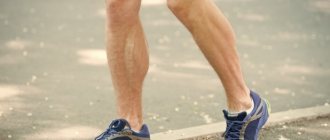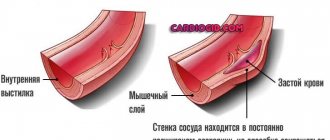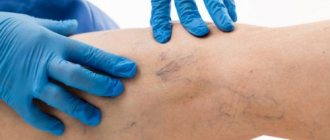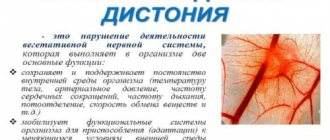The capillary mesh on the skin of the lower extremities is nothing more than the result of a failure of blood flow in small vessels. When the walls of microvessels lose density and elasticity, their structure becomes deformed and blood circulation slows down.
The result of this violation is excessive blood filling of the capillaries, the appearance of varicose veins on the surface of the skin of the legs and thighs.
If a visible vascular network appears on the legs, how to get rid of this cosmetic defect, which, moreover, poses a potential threat to health?
In this material we will talk about whether it is possible to remove spider veins on the legs and what methods of treating them exist.
Causes: diseases and provoking factors
The causes of the development of the disease may include provoking factors depending on a certain lifestyle and condition, or serious diseases. In some cases, complications may occur in the form of bursting blood vessels.
Provoking factors
The main causes of asterisks include the following provoking factors:
- hypoxia;
- hormonal changes (childbirth, menopause, pregnancy, abortion, etc.);
- heredity;
- chronic venous insufficiency;
- Exceeding the number and intensity of procedures affecting the skin (cosmetic
- manipulation, tanning, etc.);
- frostbite;
- prolonged stress;
- frequent exposure to temperature changes, including hypothermia;
- obesity;
- inactive lifestyle;
- work in a standing position;
- smoking and frequent drinking of large doses of alcohol;
- hormonal-based drugs.
Diseases
In addition to provoking circumstances, the causes of capillary mesh on the legs in some cases are the result of diseases:
- flaming nevus;
- dermatomyositis;
- ataxia;
- cirrhosis of the liver;
- rosacea and others.
Complications
Often the patient does not react to the capillary network on the legs until the vessels begin to burst. Such manifestations can be caused by trauma, hormonal imbalances, significant stress and other factors.
The main causes of complications of vascular network include vascular weakness. In this case, weakened walls cannot cope with the stress.
Reasons for the appearance of a capillary network
- Disturbances in the hormonal system;
- Consequences of excessive sun exposure;
- Hypothermia;
- Venous insufficiency;
- Consequences of taking hormonal drugs.
- Heredity;
- Increased skin sensitivity;
- Weak vessel walls.
- Poor nutrition;
- Frequent stressful situations.
- Excessive physical activity.
- Overweight;
- Pregnancy;
- Osteochondrosis.
Symptoms
The problem can be detected purely visually. The vascular network looks like thin blue and red uneven lines. Such manifestations can be not only on the legs, but also, for example, on the face. The visible network of thin vessels on the legs causes concern among women due to external unattractiveness, despite the fact that there are no other symptoms.
For your information! Spider veins on the legs often appear under the influence of estrogen, which is a female sex hormone.
In men, capillary varicose veins are a sign of venous insufficiency. In this case, serious treatment is required. Vessels (small arteries, veins and capillaries) in the form of meshes can appear in certain areas or over the entire surface of the limb.
Remedy for capillaries on legs
One of the most popular conservative methods of combating vascular patterns is the use of a topical venotonic agent. It can be either a cream, gel or ointment. The market offers various pharmacological forms of products that help strengthen blood vessels and capillaries in the legs. The most preferred is cream. It has an optimal ratio of components, making it easy to apply and distribute over the skin.
NORMAVEN® foot cream contains 12 active ingredients. Of which, extracts of ginkgo biloba, horse chestnut and lingonberry, vitamin C and lemon oil will actively act directly on the capillaries. After a 3-month course of using the product, it will be possible to note a decrease in the vascular pattern by at least 70% (the positive effect of the cream has been clinically proven). In addition to minimizing the severity of small vascular networks, testing of this product has proven other positive effects of NORMAVEN® foot cream. Its 3-month use helps get rid of cramps, swelling, a feeling of heaviness and fatigue in the lower extremities. The product was developed by specialists from the pharmaceutical company VERTEX and has a list of necessary documents and certificates.
Therapy
How to get rid of capillary mesh on the legs? Depending on the condition of the vessels, various methods of therapy may be indicated:
- symptomatic treatment;
- sclerotherapy;
- photocoagulation
- diathermocoagulation, etc.
Treatment should always be agreed with a doctor and take into account all the nuances and characteristics of a particular person’s health. To do this, the patient is prescribed an examination and anamnesis is studied.
Laser therapy
A good result can be achieved in one session. The basis of the method is the gluing of vascular walls under the influence of a laser beam. This method is progressive. Immediately after treatment of the problem area, there may be a difference in the color of the skin from the rest of the body surface. This is a temporary effect that is completely eliminated after 7 days.
Additionally, topical medications can be used. The disadvantages of the method include the high cost of the procedure, so it is often chosen to eliminate the network of blood vessels on the face rather than on the legs.
Treatment methods or how to remove capillaries on the legs
The answer to the question of how to get rid of capillaries on the legs depends on the degree of their manifestation. Methods for eliminating them can be conservative or surgical. But the first thing you need to do is contact a specialist. Only he will be able to correctly determine how and by what method to carry out therapy in each specific case.
Treatment methods for capillaries on the legs
Methods involving surgical removal of capillaries on the legs include the following procedures:
- Microsclerotherapy.
This injection treatment procedure is considered simple. It is produced by introducing a special substance into the vessel through a syringe, under the influence of which the wall of the vessel “sticks together”. The procedure is painless and quite effective;
- Thermocoagulation.
Through the alternating thermal effect of high-frequency current on the affected capillaries, the blood from them moves back to the subcutaneous vessel. The procedure is also painless, quick and clinically effective;
- Ozone therapy.
This is a relatively new method of treating vascular network. This procedure is performed intravenously. In addition to destroying damaged capillaries, ozone enriches blood vessels with oxygen and promotes their active absorption of nutrients;
- Laser coagulation.
The laser beam affects the vessel with light energy, a clot is formed, which blocks the path for blood flow. The procedure is painless and takes no more than 40 minutes. It is carried out on an outpatient basis.
All of the above methods have their advantages and disadvantages, which the attending physician must tell the patient about before prescribing.
A conservative treatment method involves the use of local agents, taking venotonic drugs, possibly wearing compression stockings and using traditional medicine recipes.
Justifiable concern is caused by the capillaries that appear on the child’s legs. What to do in this case, and what treatment methods are suitable?
!
Here the answer is clear - you need to contact a pediatrician, who will prescribe a series of laboratory tests and medical examinations.
This is necessary to accurately determine the cause of the appearance of the vascular pattern and select the most appropriate treatment method. Due to the frequency of allergic reactions in children, only a specialist can choose treatment methods.
Experts will try to eliminate capillaries on the legs during pregnancy using a set of drug-free measures. The vascular pattern may go away on its own in the postpartum period. If this does not happen, you should consult a doctor.
Treatment of capillaries on the legs: remedies
Folk remedies
Traditional medicine offers treatment methods that are highly harmless. Many of them are effective and can be used in combination with medications.
Cabbage compresses
There are many benefits to using fresh cabbage leaves. The leaves separated from the head of cabbage are doused with boiling water and placed in a plastic bag in the refrigerator for a day. The cabbage leaf compress is applied overnight so that the effect can last for a long time throughout the night. Can be fixed with a bandage. The number of such approaches should be about 15.
Kalanchoe tincture
To prepare the tincture, take a 500 ml jar. and filled with chopped Kalanchoe leaves. Boiled water is poured on top. Place in the refrigerator for 7 days, shaking the contents occasionally.
After a week, the solution is filtered. The resulting solution is used to treat the areas every day for a long time - several months.
Grape compresses
For treatment, dark grape varieties are torn off. The berries are kneaded and applied to damaged areas. For the method to be effective, it is advisable to repeat it for at least 1.5 weeks.
Apple cider vinegar compresses
For small areas, apple cider vinegar can be successfully used for treatment, the effect of which complements medications. If there is a large area of affected vessels, this remedy will not be effective.
Treatment
The treatment regimen for capillary mesh is prescribed by a phlebologist. To make a diagnosis, the patient is referred for a clinical blood test and ultrasound of large vessels.
Drug therapy
What to do if a vascular network appears on your legs - first of all, you will need to take medications, the action of which is aimed at increasing the tone of the walls of blood vessels (arterioles and venules), improving their elasticity and firmness. The following will help you remove vein veins on your legs:
- Phlebotonics or phleboprotectors. These include Troxevasin, Detralex, Aescusan, Diosmin. The drugs eliminate swelling in the ankle and calves, reduce pain, normalize vascular tone, restore blood and lymph flow,
- Nonsteroidal anti-inflammatory drugs (NSAIDs). The best remedies for spider veins are Ibuprofen, Diclofenac, Indomethacin, Ketoprofen. They are used to eliminate swelling and inflammation, have an analgesic effect,
- Blood-thinning medications - Ticlopidine, Lyoton, Venolife, Curantil. They help avoid blood clots, restore blood structure, relieve swelling, normalize lymph and blood flow,
- Diuretic tablets - Taurine, Spironolactone, Furosemide. Remove excess fluid and reduce tissue swelling.
On a note!
For complex enzyme therapy during exacerbation of varicose veins on the legs, Flogenzyme is used. The immunomodulator contains hydrolytic enzymes that allow you to quickly cope with an exacerbation. A drug containing proteolytic enzymes – Wobenzym – is prescribed for chronic varicose veins to prevent complications.
Hardware cosmetology
How and how to treat vein veins on the legs if medications are ineffective? In this case, hardware cosmetology procedures will help:
- Photocoagulation or laser therapy. Laser treatment helps to get rid of the manifestations of the vascular network and enlarged capillaries (the diameter of which does not exceed 1 mm). You can get rid of larger vascular networks using a neodymium laser. This device allows you to eliminate large vessels with a diameter of 1 to 6 millimeters,
- Sclerotherapy is the injection of a specialized medication (sclerosant) into the lumen of blood vessels. The substance seals (glues) damaged parts of the vessel,
- Ozone treatment. A mixture of ozone and oxygen is introduced into the lumen of the vessel using a microneedle, which starts the process of oxidation of the cell membranes of the vein walls. Due to this, the vascular network completely disappears.
On a note!
An additional method of therapy for spider veins on the legs is wearing special compression garments. The degree of compression is determined by the doctor, based on the individual characteristics of the patients and the degree of progression of the pathology.
Traditional methods of treatment
Recipes from traditional healers will help you remove spider veins on your legs at home. Such medications have proven their effectiveness and safety over decades of use. Another advantage of folk recipes for vascular mesh is low cost.
Homemade ointments and compresses are the most popular ways to treat spider veins on the legs:
- Green parsley compress. Parsley leaves are torn off, placed in a jar and steamed with boiling water. After half an hour, filter and add milk in a 1:1 ratio. A clean cloth or gauze is moistened in the solution, lightly wrung out and applied to problem areas of the skin of the legs,
- Rubbing from Kalanchoe. Trim a leaf from an old plant, wash and dry. Chop with a knife, put in a half-liter jar, and fill with cold boiled water. Leave to brew in a cool, dark place for a week. Strain through cheesecloth. The resulting solution is used for grinding. It is important to carry out massage movements from bottom to top. Rubbing is carried out daily for 30-60 days,
- Aloe juice. Cut off a large leaf. Leave in the refrigerator for 2-3 days. Cut and wipe areas of the skin of the legs with pronounced vascular network. During the first manipulations, irritation or tingling may occur. Discomfort disappears after 2-3 procedures. You can squeeze juice from aloe leaves or prepare an ointment by mixing the crushed leaf with oil or lard. Massage with aloe juice for a month.
Another popular folk remedy for varicose veins and spider veins on the legs is apple cider vinegar. This is due to its tonic and strengthening effect on the walls of blood vessels.
Important!
Apple cider vinegar restores normal blood circulation and quickly eliminates swelling.
Popular recipes for folk remedies based on apple cider vinegar:
- Rubbing. Soak a clean cotton cloth or gauze in apple cider vinegar and rub areas of the skin with pronounced vascular network,
- Vinegar compress. Soak a small towel in apple essence, wring it out, and wrap it around your feet. Lie down with your legs resting on the cushion. Rest until the compress is completely dry. This usually takes 20 to 30 minutes,
- Vinegar wraps. Lie down with a pillow under your feet. Soak gauze or bandage well in vinegar and place it in place of the vascular network. Wrap the top with film and a terry towel. Leave for an hour
- In the morning before meals, drink a glass of water containing 2 tablespoons of apple cider vinegar. To make the drink more enjoyable, you can add a spoonful of honey.
Diet
To get rid of vascular network, in addition to drug treatment, a balanced diet is required. By following a special diet, you can maintain the health of your legs and prevent the re-formation of vascular patterns.
Basics of diet for pathology:
- Reducing the amount of salt consumed,
- Refusal of spices and herbs,
- Complete ban on alcohol and caffeinated drinks (tea, coffee, energy drinks),
- Reducing the consumption of confectionery, baked goods, sweets,
- Introducing foods containing magnesium and potassium into the diet - prunes, dried apricots, citrus fruits, nuts, cranberries.
On a note!
In addition to a balanced diet, patients suffering from a network of blood vessels require daily moderate exercise. The optimal solution is to perform physical therapy exercises or go swimming. Dosed physical activity promotes a speedy recovery.
Prevention
Completely getting rid of the vascular network with the help of tablets and gels is not possible, so it is all the more important to take preventive measures to prevent the development of pathology. If there are factors predisposing to the development of the disease, it is advisable to proceed to preventive measures:
- wear comfortable shoes and low heels;
- use of relaxing foot baths;
- cold and hot shower;
- therapeutic physical culture in the form of simple exercises.
Since there is no ideal remedy for preventing the occurrence of spider veins, prevention can include a healthy lifestyle, careful attention to health, and timely treatment in all cases where it is necessary.
—
Adviсe
- Broken capillaries are the initial stage of many diseases of the lower extremities, so it is better to get rid of them immediately to avoid complications.
- If symptoms appear, you should consult a specialist, and he will prescribe medication and recommend any cosmetic procedure.
- To restore the body and get rid of stars, you need to eat right, including in your diet as many fresh fruits, vegetables and herbs as possible.
- Perform daily physical activity.











